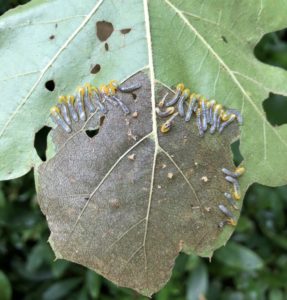Sawflies Feeding on Oaks
go.ncsu.edu/readext?547611
en Español / em Português
El inglés es el idioma de control de esta página. En la medida en que haya algún conflicto entre la traducción al inglés y la traducción, el inglés prevalece.
Al hacer clic en el enlace de traducción se activa un servicio de traducción gratuito para convertir la página al español. Al igual que con cualquier traducción por Internet, la conversión no es sensible al contexto y puede que no traduzca el texto en su significado original. NC State Extension no garantiza la exactitud del texto traducido. Por favor, tenga en cuenta que algunas aplicaciones y/o servicios pueden no funcionar como se espera cuando se traducen.
Português
Inglês é o idioma de controle desta página. Na medida que haja algum conflito entre o texto original em Inglês e a tradução, o Inglês prevalece.
Ao clicar no link de tradução, um serviço gratuito de tradução será ativado para converter a página para o Português. Como em qualquer tradução pela internet, a conversão não é sensivel ao contexto e pode não ocorrer a tradução para o significado orginal. O serviço de Extensão da Carolina do Norte (NC State Extension) não garante a exatidão do texto traduzido. Por favor, observe que algumas funções ou serviços podem não funcionar como esperado após a tradução.
English
English is the controlling language of this page. To the extent there is any conflict between the English text and the translation, English controls.
Clicking on the translation link activates a free translation service to convert the page to Spanish. As with any Internet translation, the conversion is not context-sensitive and may not translate the text to its original meaning. NC State Extension does not guarantee the accuracy of the translated text. Please note that some applications and/or services may not function as expected when translated.
Collapse ▲Oaks have hundreds of herbivores so it is no wonder that towards the end of summer some of the leaves show all types of feeding damage. Last week I found many trees with leaves that had damage called ‘window paning.’
This type of damage occurs when a small herbivore feeds on the lower surface of a leaf but leaves a thin layer of the upper surface intact. Thus, if you hold the leaf up

Sawfly larvae, probably Caliroa quercuscoccineae, on a red oak and the window pane damage they cause. Photo: SD Frank
to light you can see through it, mostly. The remaining layer of leaf quickly turns brown. Lots of this feeding can make trees look tattered. Right now some of this damage is from the scarlet oak sawfly, Caliroa quercuscoccineae. Sawfly larvae, like hibiscus sawflies, birch sawflies, and some rose sawflies, often look like caterpillars even though they are actually wasp larvae. This species and many others look more like slugs. Generally, these do not cause major defoliation in landscape trees or street trees and do not need management. It is just nice to be able to explain some of the browning and minor damage folks may be seeing.
Read the full article:


